Drive.bat virus (Removal Guide) - May 2018 update
Drive.bat virus Removal Guide
What is Drive.bat virus?
Drive.bat virus is a dangerous Trojan horse which is capable of damaging victim's data and making it useless
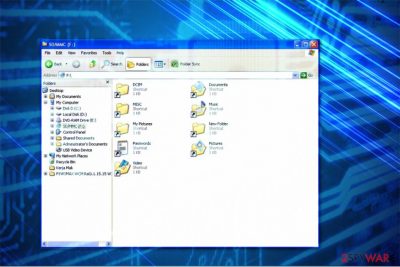
Drive.bat virus is a malicious cyber infection classified as a Trojan horse.[1] PC users can download it by clicking on a malicious ads, downloading drive.zip file, opening spam e-mails or file-bundles. However, it manages to proliferate since 2004 by spreading via external devices, like SD cards, USB flash drives, hard-drives, etc. Once the virus infects the external device, all files and folders stored on it are transformed into the shortcuts similar to the one of a USB device. Consequently, the data cannot be opened and becomes unreadable. Consequently, the Trojan is often dubbed as Drive.bat shortcut virus.
| Name | Drive.bat virus |
|---|---|
| Type | Trojan |
| Other references | Drive.bat shortcut virus, Drive.bat usb Trojan |
| Distribution | Via external drivers, drive.zip file, spam email attachments, software bundling |
| Danger Level | High. Can cause permanent data loss stored on any external drive connected to the infected PC |
| Symptoms | Files and folders on external drive (USB, SD card, USB hard drive, etc.) are transformed into shortcuts. |
| Elimination | Automatic only. Trojan can be utilized with a help of an updated and powerful anti-malware tool. We recommend FortectIntego. |
Usually, the files corrupted by Drive.bat feature 1 KB size and seem to be completely lost. Luckily, analysis by NoVirus.uk[2] experts have revealed that the virus does not delete the data, just hides it from the victim. The Trojan merely corrupts the display of data hierarchy.
Thus, you should remove Drive.bat to be able to re-access your files. This elimination process might be confusing for inexperienced computer users. We suggest using a reputable anti-malware software to eliminate the trojan.
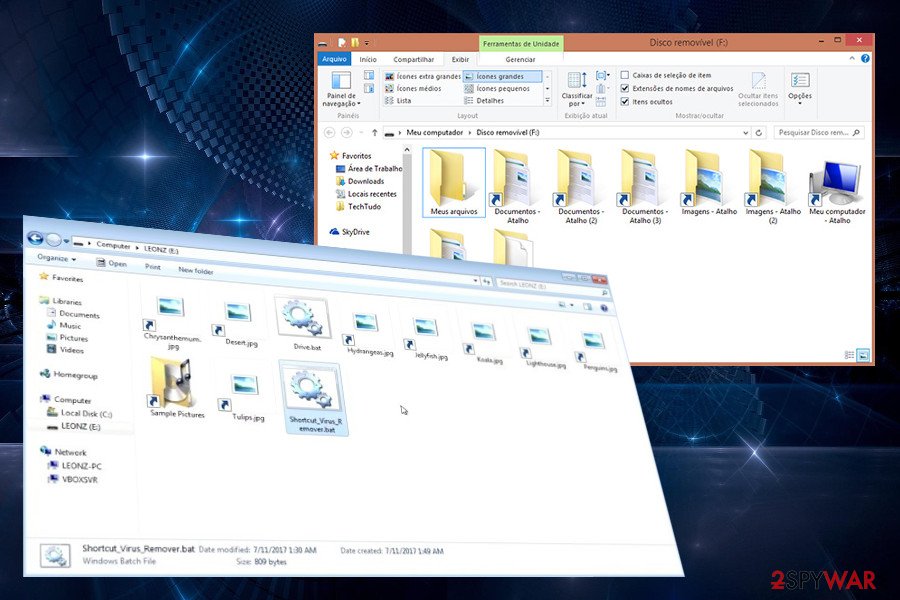
Besides, the infected shortcut is designed to spread Drive.bat via connected systems, e.g. your computer and other external devices that might be connected to it. Many victims get lured into clicking it by thinking that it will lead them to the corrupted data. However, this act is precisely what attackers want them to believe. You should NOT open the shortcut under any circumstances.
Moreover, cybersecurity experts warn that this virus can start acting as a backdoor in the future. If these claims are true, it can be used for infecting systems with ransomware or other high-risk PC infections[3].
Infected victims have already outlined their experience on a IT forums. It turns out that this cyber threat might block Windows Updates and anti-virus software (from both installing and launching) even when in Safe Mode. Besides, the Internet connection may also cause chaos by turning on and off unexpectedly. Obviously, to prevent these issues, you need to get rid of Drive.bat virus.
To take care of your system and prevent malware attack, we recommend employing a powerful security software. It will also help you to start Drive.bat removal instantly. You could use FortectIntego or SpyHunter 5Combo Cleaner since they will not only eliminate the trojan but also maintain your security in the future.
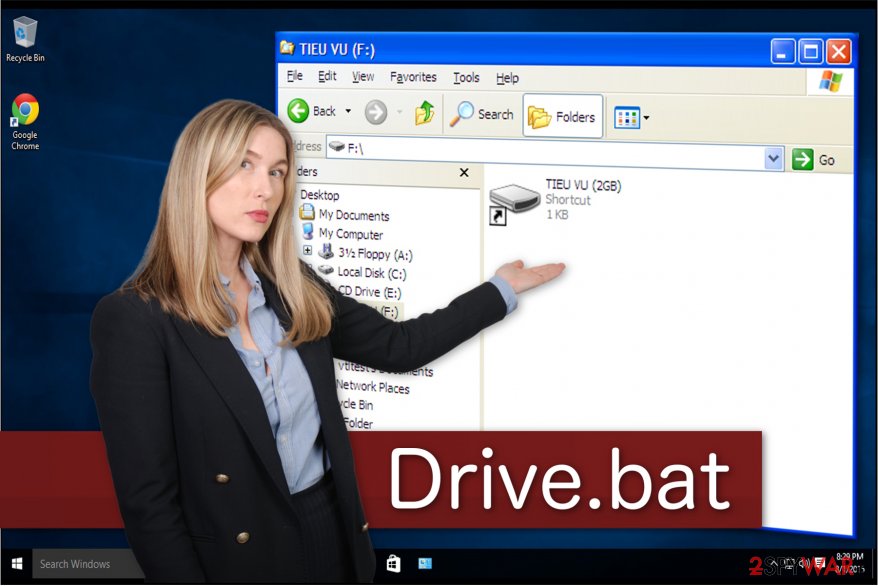
Be aware that eliminating the malicious program is not enough. You should make sure to follow the below-listed tips to avoid Drive.bat virus infection afterward:
- Keep your system protected by employing reputable anti-malware;
- Back up your files and valuable data;
- Do not open any suspicious e-mails or attachments sent by people or organizations you don’t know;
- Download applications only from authorized sources.
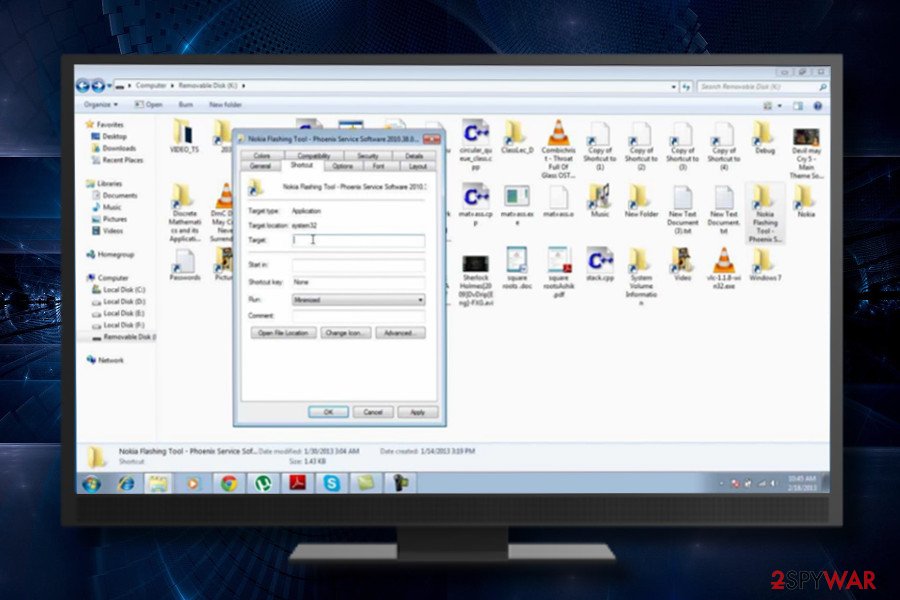
Find out how you can get infected with the file-hiding virus
Criminals aim to infiltrate trojans on as many computers as possible. Thus they use not one but many methods for distribution.
Drive.bat spreads via:
- Malicious drive.zip file;
- Spam e-mails containing a malicious attachment or link;
- Rogue advertisements displayed on highly suspicious websites;
- File-bundles of third-party apps that hide the information about the installation of the trojan;
- Illegal Torrent downloads.
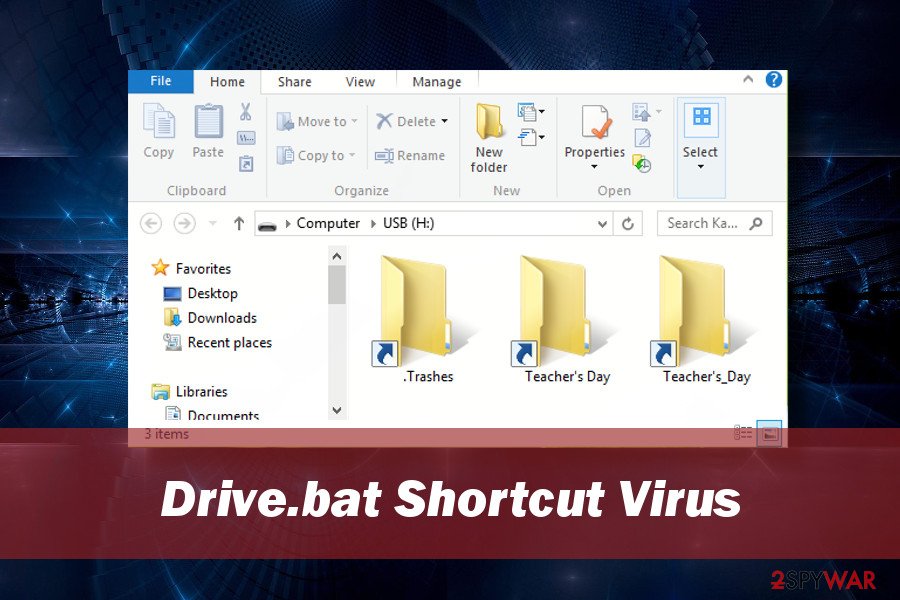
Eliminate Drive.bat to retrieve access to your files
Trojans often are able to hide their presence or traces. Therefore, manual Drive.bat removal is almost an impossible challenge for those who do not possess specific IT skills. You shouldn’t try to get rid of the virus by yourself, or you risk damaging corrupted files permanently. Instead, pick a professional security software that will solve your question “How to remove Drive.bat from your system” with only one click.
There is a possibility that the malware will not allow you to download an anti-virus program. To avoid that, you should reboot your PC to Safe Mode. It will deactivate the virus and permit to run a full system scan.
Eliminate the main shortcut of the virus from external drive automatically
- Open My Computer or This PC and right-click on the external drive that is infected with a shortcut Trojan.
- Select Scan for viruses option.
- Select the security tool that you prefer using and let it scan the removable drive.
- Alternatively, you can open Windows Defender and access its Settings.
- Open the Advanced section and select Scan removable drives.
- Select the security tool
Get rid of shortcut Trojan from external drive using Command Prompt (Admin)
- Right-click on Windows key and select Command Prompt (Admin).
- You can also open Command Prompt (Admin) by typing cmd into the search. Right-click on the search result and select Run as Administrator.
- Now type the letter of your USB (e.g. E:) and press Enter.
- Type del *.lnk and press Enter.
- Once the command is executed, copy and paste the attrib -s -r -h *.* /s.d/l/ command. Press Enter to execute it.
- Now open the external drive and check whether the data was restored.
Getting rid of Drive.bat virus. Follow these steps
Manual removal using Safe Mode
If you want to get rid of this torjan horse, follow the instructions below that explain how to reboot your computer so Safe Mode with Networking.
Important! →
Manual removal guide might be too complicated for regular computer users. It requires advanced IT knowledge to be performed correctly (if vital system files are removed or damaged, it might result in full Windows compromise), and it also might take hours to complete. Therefore, we highly advise using the automatic method provided above instead.
Step 1. Access Safe Mode with Networking
Manual malware removal should be best performed in the Safe Mode environment.
Windows 7 / Vista / XP
- Click Start > Shutdown > Restart > OK.
- When your computer becomes active, start pressing F8 button (if that does not work, try F2, F12, Del, etc. – it all depends on your motherboard model) multiple times until you see the Advanced Boot Options window.
- Select Safe Mode with Networking from the list.

Windows 10 / Windows 8
- Right-click on Start button and select Settings.

- Scroll down to pick Update & Security.

- On the left side of the window, pick Recovery.
- Now scroll down to find Advanced Startup section.
- Click Restart now.

- Select Troubleshoot.

- Go to Advanced options.

- Select Startup Settings.

- Press Restart.
- Now press 5 or click 5) Enable Safe Mode with Networking.

Step 2. Shut down suspicious processes
Windows Task Manager is a useful tool that shows all the processes running in the background. If malware is running a process, you need to shut it down:
- Press Ctrl + Shift + Esc on your keyboard to open Windows Task Manager.
- Click on More details.

- Scroll down to Background processes section, and look for anything suspicious.
- Right-click and select Open file location.

- Go back to the process, right-click and pick End Task.

- Delete the contents of the malicious folder.
Step 3. Check program Startup
- Press Ctrl + Shift + Esc on your keyboard to open Windows Task Manager.
- Go to Startup tab.
- Right-click on the suspicious program and pick Disable.

Step 4. Delete virus files
Malware-related files can be found in various places within your computer. Here are instructions that could help you find them:
- Type in Disk Cleanup in Windows search and press Enter.

- Select the drive you want to clean (C: is your main drive by default and is likely to be the one that has malicious files in).
- Scroll through the Files to delete list and select the following:
Temporary Internet Files
Downloads
Recycle Bin
Temporary files - Pick Clean up system files.

- You can also look for other malicious files hidden in the following folders (type these entries in Windows Search and press Enter):
%AppData%
%LocalAppData%
%ProgramData%
%WinDir%
After you are finished, reboot the PC in normal mode.
Remove Drive.bat using System Restore
If the first method doesn't work, you should try Command Prompt function to uninstall Drive.bat from your system.
-
Step 1: Reboot your computer to Safe Mode with Command Prompt
Windows 7 / Vista / XP- Click Start → Shutdown → Restart → OK.
- When your computer becomes active, start pressing F8 multiple times until you see the Advanced Boot Options window.
-
Select Command Prompt from the list

Windows 10 / Windows 8- Press the Power button at the Windows login screen. Now press and hold Shift, which is on your keyboard, and click Restart..
- Now select Troubleshoot → Advanced options → Startup Settings and finally press Restart.
-
Once your computer becomes active, select Enable Safe Mode with Command Prompt in Startup Settings window.

-
Step 2: Restore your system files and settings
-
Once the Command Prompt window shows up, enter cd restore and click Enter.

-
Now type rstrui.exe and press Enter again..

-
When a new window shows up, click Next and select your restore point that is prior the infiltration of Drive.bat. After doing that, click Next.


-
Now click Yes to start system restore.

-
Once the Command Prompt window shows up, enter cd restore and click Enter.
Finally, you should always think about the protection of crypto-ransomwares. In order to protect your computer from Drive.bat and other ransomwares, use a reputable anti-spyware, such as FortectIntego, SpyHunter 5Combo Cleaner or Malwarebytes
How to prevent from getting trojans
Protect your privacy – employ a VPN
There are several ways how to make your online time more private – you can access an incognito tab. However, there is no secret that even in this mode, you are tracked for advertising purposes. There is a way to add an extra layer of protection and create a completely anonymous web browsing practice with the help of Private Internet Access VPN. This software reroutes traffic through different servers, thus leaving your IP address and geolocation in disguise. Besides, it is based on a strict no-log policy, meaning that no data will be recorded, leaked, and available for both first and third parties. The combination of a secure web browser and Private Internet Access VPN will let you browse the Internet without a feeling of being spied or targeted by criminals.
No backups? No problem. Use a data recovery tool
If you wonder how data loss can occur, you should not look any further for answers – human errors, malware attacks, hardware failures, power cuts, natural disasters, or even simple negligence. In some cases, lost files are extremely important, and many straight out panic when such an unfortunate course of events happen. Due to this, you should always ensure that you prepare proper data backups on a regular basis.
If you were caught by surprise and did not have any backups to restore your files from, not everything is lost. Data Recovery Pro is one of the leading file recovery solutions you can find on the market – it is likely to restore even lost emails or data located on an external device.
- ^ What is a Trojan Virus?. Kaspersky Lab. Kaspersky Antivirus Protection & Internet Security.
- ^ NoVirus. NoVirus. Security and Spyware News.
- ^ Shahram Monshi Pouri, Nikunj Modi. Trojans and Backdoors. Department of Information and Technology. Systems and Control.





















